|


| |

| Philip
IV / Felipe IV
8 Reales 1627 P Nuevo Reino
Henry Christensen (Associated Coin
Corporation) auction June 1958 lot # 1449
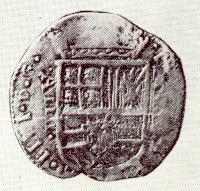
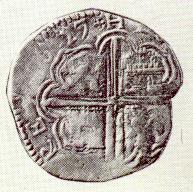
Click image to enlarge
/ Haz clic la imagen para agrandarla |
Obverse:
Crowned Habsburg shield, with small triangle at bottom. It is
difficult to see in the photo, but it appears that the castles and lions
for Castile and Leon are in the correct order. To the left of the shield is the vertical numeral
IIIIV, for the denomination 8 reales, reading downward. The
V of the denomination is actually an inverted
"A" and the number is VIIII (9) if read in reverse order. To the
right of the
shield is NRP: NR is the mint mark for Nuevo Reino and P is the
assayer mark for Miguel Pinto Camargo. The legend around the
periphery reads: "P(HIL)IPP(VS) ·
IIII · D · G". Reverse: Cross surrounded
by 8 arcs. In the quarters of the cross are castles and lions,
for Castile and Leon, swapped from the correct location.
The legend around the periphery reads "HI(SPANIARVM ·) RE(X ·
1)627". R/L M44-9,
L/R M44S-9, C&T Type 103, number 522. Anverso: Escudo
de Hasburgo coronado, con pequeño triángulo en la base. Es
difícil apreciar en la foto pero parece que los castillos y los
leones por Castilla y León, están en el orden correcto. A la
izquierda se encuentra el numeral IIIIV en posición vertical, por
la denominación de 8 reales; se lee hacia abajo. El V de la
denominación es en realidad una “A” invertida y el número que
es VIIII (9) se lee al revés. Hacia la derecha está NRP: NR es la
marca de ceca por Nuevo Reino y P es la marca del ensayador Miguel
Pinto Camargo. En la leyenda de la periferia se lee: "P(HIL)IPP(VS)
· IIII · D · G". Reverso: Cruz rodeada por
8 arcos. In los cuarteles de la cruz hay castillos y leones, por
Castilla y León, en orden cambiado. La leyenda de la periferia
dice: "HI(SPANIARVM ·) RE(X · 1)627".
|
This famous
and well published eight reales of Nuevo Reino is actually dated
1627, even though the photograph appears to be 1625. The study
of Nuevo Reino coins was greatly advanced by the publication of two
now classic numismatic works. The first was F. Xavier Calico's
"Aportación a la
Historia Monetaria de Santa Fe de Bogotá (Colombia)" published in
1953. The subject coin was not included in this work because
the coin wasn't published until the Christensen sale of June 1958.
The second classic work on Nuevo Reino was Robert Nesmith's "A Hoard of the First
Silver Coins of Nuevo Reino de Granada (Colombia)," The Centennial
Publication of The American Numismatic Society" published in the
same year as the Christensen auction, 1958, but likely the
Nesmith text was completed before this coin was sold, because there
is no mention of it in Nesmith. Esta
famosa y muy publicada moneda de ocho reales está en realidad
fechada 1627, aun cuando la foto parece que fuera 1625. El
estudio de las monedas de Nuevo Reino progresó con la publicación
de dos artículos que ya son clásicos. El primero fue "Aportación
a la Historia Monetaria de Santa Fe de Bogotá (Colombia)",
de F. Xavier Calicó, publicado en 1953. La aludida moneda no fue
incluida en esta obra porque no fue publicada hasta la subasta de
Christensen en 1958. La segunda obra clásica sobre Nuevo Reino fue
"A Hoard of the First Silver Coins of Nuevo Reino de Granada
(Colombia)", The Centennial Publication of The American
Numismatic Society de Robert Nesmith, publicada en 1958, el mismo
año de la subasta de Christensen. Probablemente el texto de Nesmith
fue terminado antes de la venta de esta moneda pues Nesmith no la
menciona.
|
Dating
the coin to 1627 - four points. First,
the
coin was listed in the auction sale of the "Associated Coin
Corporation" operated under the names of Henry Christensen and Robert
McAusland. The address given for the Associated Coin
Corporation was Suite 714, MU 7-3060, 545 Fifth Avenue, New York 17,
New York at Fifth and 45th. The sale was held at the Madison
Room of the Hotel Roosevelt in New York City. There were 2440
lots sold in three sessions over the two day period of June 13 and 14,
1958. The subject coin was lot 1449, below is the lot
description showing the date as 1627. 
The
catalogers declare that the coin was previously unpublished,
therefore this is the first appearance of the coin in a public
photograph.
The description says 1627 but the photo looks like 1625. If
one studies the photo and looks past the glare and shadows in the
final digit, you can see that it may be a 7. We believe the catalogers
were correct in reading the date as 1627, for they had the actual
coin in hand to study, and the coin had an estimate of $350, which
was a high price for a coin in 1958; in fact, lot 1461 of the same
sale was a 1759 Nuevo Reino pillar 8R with an estimate of
$200, so $350 was a high valuation indeed. For such a valuable coin we think the catalogers would
have made a best attempt to catalog the coin correctly.
Cuatro
Puntos para Fechar la moneda como de 1627
Primero,
la moneda fue incluida en la subasta de la "Associated Coin
Corporation" que funcionaba como de Henry Christensen y Robert
McAusland. La dirección que se dio para la Corporación fue Suite
714, MU 7-3060, 545 Fifth Avenue, New York, 17, New York at Fifth
and 45th. La subasta tuvo lugar en el salón Madison del Hotel
Roosevelt de la ciudad de Nueva York. Se vendieron 2440 lotes en
tres sesiones durante dos días, desde junio 13 hasta 14. La moneda
de que hablamos fue el lote 1449. Arriba está la descripción del
lote fechado 1627. Los catalogadores declararon que la moneda
no había sido publicada previamente por lo tanto esta es la primera
aparición de una fotografía de esta pieza. La descripción dice
1627 pero la moneda parece que fuera de 1625. Si uno la observa por
debajo de la sombra y brillo superiores, se ve que puede ser un 7.
Creemos que los catalogador tuvieron razón en leer la fecha como
1627 pues tenían el espécimen a la mano para estudiarla y el
precio estimado eran $US350 que era alto en 1958, puesen la misma
subasta se ofrecían 8 reales columnarios de 1759, Nuevo Reino, con
una estimación de $US200, así que $350 era realmente una
valoración alta. Para una pieza tan valiosa los catalogadores
seguramente hicieron el mayor esfuerzo para presentarla
correctamente. |
|
The
second point to consider in determining whether the final digit of the
date is a 5 or 7, is the style of the numeral 5. The style of
the Spanish 5 in the early 17th century was curved, not like an
Arabic 5, as
it would have to be for this coin to be dated 1625. Shown is
an example of the Spanish "5" from a 1625 dated 8R of
Segovia, notice the sweeping curves. The image is from the 1998
edition of Las Monedas Españolas, used with the kind
permission of the Cayón firm of Madrid.
El
segundo punto para determinar si el último número era un 5
o un 7, es el estilo del numeral 5. El estilo del 5 español de
principios del siglo XVII, era curvo no como un 5 arábigo, como
tendría que ser éste si fuera de 1625. Se muestra un ejemplo del
“5”español en una pieza de 8 reales de 1625 de Segovia,
nótense las curvas. La imagen fue tomada de la edición de 1998 de
las Monedas Españolas, con la amable autorización de la firma
Cayón de Madrid. |
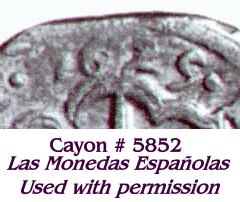
|
The
third and very important point to consider is the assayer initial
"P". The assayer initial P is for Miguel Pinto
Camargo, who is recorded having worked as assayer at Nuevo Reino
(Santa Fe) from 1627 to 1632. This is recorded in Barriga's
"Historia de la Casa de Moneda" volume I page 50. We
now know that Colombian mint(s) produced coins before 1627, but we
don't know if Pinto was an assayer before 1627, and the information
in Barriga suggests not. Therefore, we believe that a coin
with assayer mark "P" for Pinto would most likely be 1627
or later, not 1625.
El
tercero y muy importante punto es considerar la marca de
ensayador “P” por Miguel Pinto Camargo, quien se sabe trabajó
como ensayador de Nuevo Reino(Santa Fe) de 1627 a 1632 como está
anotado en "Historia de la Casa de Moneda", volumen I
página 50, de Barriga Villalba. Sabemos que las cecas de Colombia
produjeron monedas antes de 1627, pero no sabemos si Pinto fue
ensayador antes de 1627. La información que hay en Barriga sugiere
que no. Por eso creemos que una moneda con marca de ensayador
“P”es más probablemente de 1627 o posterior.
The
fourth point is a close examination of the photograph. We
took the photograph and did some simple edits to try and eliminate
the glare and shadows on the date, here are the results. We did not touch
the photo in any way except as listed under the image.
El
cuarto punto es el examen cuidadoso de la foto. Tomamos la
foto y le hicimos sencillos cambios de edición para tratar de
eliminar el brillo y las sombras de la fecha, aquí están los
resultados. No tocamos la foto en forma alguna distinta a lo anotado
debajo de la imagen.
Click image to enlarge
/ Haz clic la imagen para agrandarla |
|
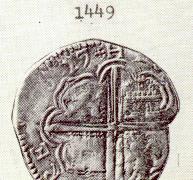
Un-retouched image
Imagen no retocada |
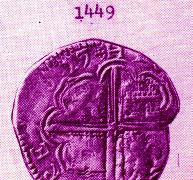
Removed all green from image
Se le quita todo el verde |
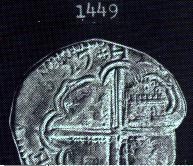
Negative image
Imagen negativa |
|
Many
references list the 1625 and some have an illustration, all the
illustrations we have seen are copies of the one in the Christensen catalog, we
determined this from the white line that goes across the page in the
catalog and passes through the final "I" of the king's ordinal IIII.
Some references list 1625
and 1627 dates, the 1627 date is still valid and corresponds to the
illustrated coin. In our opinion, the 1625 date is incorrect
and we hope publishers consider our findings when producing future editions of numismatic works.
Muchas
referencias anotan la fecha 1625 y algunos traen ilustración. Todas
la ilustraciones que hemos visto son copias de una en el catálogo
de Christensen. Descubrimos esto por la línea blanda que va a
través de la página en el catálogo y pasa hasta I de el ordinal
IIII del rey. Algunas referencias incluyen 1625 y 1627. 1627 es
válida y corresponde a la moneda ilustrada. En nuestra opinión la
fecha 1625 es incorrecta y esperamos que los editores tengan en
cuenta nuestros hallazgos en futuras publicaciones. |
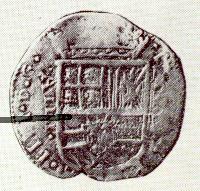
|
References
cited / Referencias citados Barriga
Villalba, A.M. 1969. Historia de la
Casa de Moneda. Bogotá: Banco de la Republica (de Colombia) 3 tomos.
Calicó, F. Xavier. 1953. Aportación a la
Historia Monetaria de Santa Fe de Bogotá (Colombia). Barcelona:
Xavier and Ferrán Calicó.
Cayón, Adolfo, Clemente
Cayón and Juan Cayón. 1998. Las Monedas Españolas, Del tremis al euro, Del 411 a nuestros días.
Madrid: Private printing.
Christensen, Henry & McAusland, Robert. 1958. Public
Auction Sale, June 13-14, 1958. New York, New York.
Nesmith, R.I. 1958. "A Hoard of the First
Silver Coins of Nuevo Reino de Granada (Colombia)," The Centennial
Publication of The American Numismatic Society. New York: American
Numismatic Society. |
There
is no copyright indicated on the Associated Coin
Corporation catalog and we assume it is in the
public domain. / Como no se indican derechos de autor en el
catálogo de ”Asociated Coin Corporation”, asumimos que es de dominio
público.
©Copyright Herman Blanton 2002, all
rights reserved.
|










